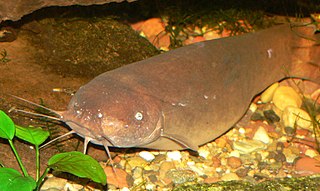
The Doradidae are a family of catfishes also known as thorny catfishes, raphael catfishes or talking catfishes. These fish are native to South America, primarily the Amazon basin and the Guianas.

The Bagridae are a family of catfish that are native to Africa (Bagrus) and Asia from Japan to Borneo. It includes about 245 species. These fish are commonly known as naked catfishes or bagrid catfishes.

The loach catfishes are a family, Amphiliidae, of catfishes. They are widespread in tropical Africa, but are most common in streams at high elevations; most species are able to cling to rocks in fast-flowing streams. The 13 genera contain 68 species.

Sisoridae is a family of catfishes. These Asian catfishes live in fast-moving waters and often have adaptations that allow them to adhere to objects in their habitats. The family includes about 235 species.

Malapterurus is a genus of catfishes of the electric catfish family (Malapteruridae). It includes 18 species.

The Jau catfish or Gilded Catfish is a South American catfish of the family Pimelodidae. It is also known as manguruyu or black manguruyu.

Olyra is a genus of catfishes of the family Bagridae. This genus occurs throughout South Asia and western Indochina, from India to western Thailand.

Rita is a genus of fish in the family Bagridae found in South Asia. These species have a single pair of mandibular barbels, an elongated Weberian apparatus firmly sutured to the basioccipital and the sensory canal on the posttemporal enclosed with bone.
Pseudomystus is a genus of catfishes of the family Bagridae.

Andersonia leptura is a species of catfish of the family Amphiliidae, and is the only species of the genus Andersonia. This fish grows to about 50.0 cm (19.7 in) in total length; it is found in the Omo, Niger, and Upper Nile Rivers and the Lake Chad basin, and is also known from Lake Debo. Although previously considered to be toothless on the lower jaw, dentition has been found on the premaxilla and the dentary. The teeth are embedded in the mucous sheath that covers the head and extends into the oral cavity, which makes the teeth difficult to see with the naked eye.

Ictalurus is a genus of North American freshwater catfishes. It includes the well-known channel catfish and blue catfish.

Amphilius is a genus of catfishes of the family Amphiliidae.

Chrysichthys is a genus of claroteid catfishes native to Africa. Two fossil species are known. Chrysichthys macrotis, Van Neer, 1994, is known from the Miocene-Pliocene of the Albertine Rift in Uganda and Chrysichthys mahengeensis, Murray & Budney, 2003, is known from the Eocene of Mahenge, Tanzania.

Phractura is a genus of loach catfishes that occur in Africa.
Tetracamphilius is a genus of catfishes of the family Amphiliidae. It includes four species.

Galeichthys is a genus of sea catfishes in the family Ariidae, the only genus in the subfamily Galeichthyinae. It includes four predominantly marine species distributed in Southern Africa and northwestern South America:

Batrachocephalus mino, the beardless sea catfish, is the only species of catfish in the genus Batrachocephalus of the family Ariidae. This species occurs in marine and brackish waters of Bay of Bengal, and parts of the western central Pacific, in coastal waters, estuaries, and lower reaches of rivers. It is distributed from Pakistan, India, Sri Lanka, Bangladesh, Myanmar, Malaysia, Thailand, to Indonesia.
Siluranodon auritus is the only species in the genus Siluranodon of the catfish family Schilbeidae.
Eaglesomia is an extinct genus of freshwater catfish, most likely of the family Claroteidae, that inhabited western Africa during the Eocene. It contains a single species, E. eaglesomei, known from the presumably Lutetian-aged marine Oshosun and Ameki Formations of Nigeria.

Heterobranchus is a genus of airbreathing catfishes native to Africa. However, H. palaeindicus, an extinct species of the genus, was discovered in the Siwalik Hills, India, dating to the Lower Pliocene.
















